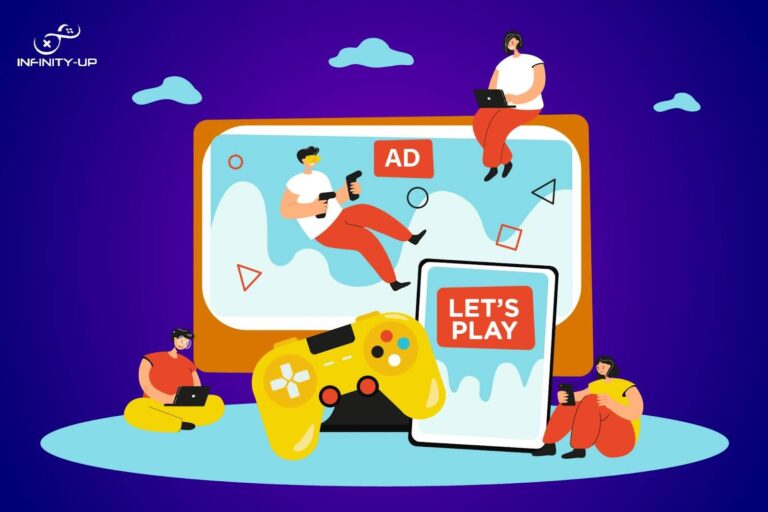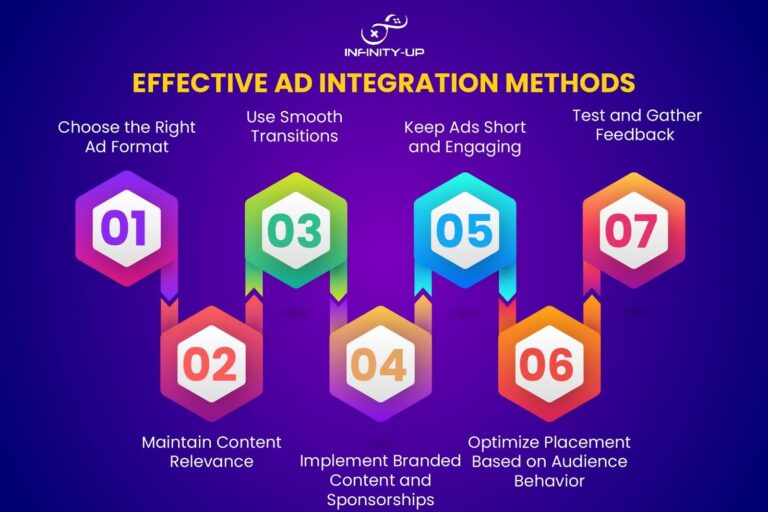How to Integrate Ads Smoothly in a Video Game
How to Integrate Ads Smoothly in a Video Game
Introduction
With the rapid growth of the gaming industry, in-game advertising has emerged as a highly effective marketing strategy. By seamlessly integrating ads into video games, companies can connect with consumers while they enjoy their favorite games, creating a unique and engaging advertising experience.
This article explores simple yet effective strategies for integrating ads into gameplay. You’ll discover how to avoid common mistakes, enhance the user experience, and maintain a steady revenue stream from your game.

In-Game Advertising and Its Benefits
In-game advertising refers to the strategic placement of ads within video games, making it a powerful marketing move for brands. This can range from traditional banner ads to seamless brand integrations like product placements and branded merchandise. Marketing through Video Games allows brands to capture players’ attention, enhance visibility, and drive engagement organically and interactively.
Types of In-Game Advertising
Static In-Game Ads:
Fixed ads placed within the game environment (e.g., billboards in racing games).
Dynamic In-Game Ads:
Real-time advertisements that can be updated (e.g., changing banners in online games).
Rewarded Video Ads:
Players watch ads in exchange for in-game rewards (e.g., extra lives, currency).
Branded Content & Sponsorships:
Brands collaborate with game developers to create custom content (e.g., in-game characters wearing branded outfits).
Advergames:
Games created specifically to promote a brand or product.
Benefits of In-Game Advertising
Higher Engagement & Involvement:
Gamers spend hours interacting with virtual worlds, making in-game ads more engaging than traditional advertising methods. Since the ads blend smoothly into the gameplay, they feel less intrusive and enhance Involvement.
Precise Targeting:
In-game ads allow brands to target specific demographics based on players’ interests, gaming habits, and behaviors. Advanced analytics help advertisers reach the right audience efficiently.
Monetization for Developers:
Game developers can generate additional revenue streams by integrating in-game ads without disrupting the user experience. Rewarded ads and non-intrusive placements enhance profitability without pushing players away.
Expanding Market Reach:
The global gaming industry is massive, with billions of players worldwide. In-game advertising enables brands to tap into this diverse and highly engaged audience across multiple platforms, including Mobile and PC Games.
Brand Recall & Awareness:
Players often recall in-game ads more effectively than traditional online ads because they are actively engaged in the game environment. This leads to better brand recognition and recall.
Non-Disruptive Experience:
Unlike pop-ups or forced video ads, in-game advertisements can be integrated seamlessly into the game world. This ensures a smoother experience while still delivering promotional content.

Why do ads frustrate players?
Players often react negatively to ads when they:
Appear unexpectedly:
Nobody likes it when an ad pops up suddenly in the middle of exciting gameplay.
Interrupt the game:
Ads should not break the game’s flow, especially during crucial moments.
Technical issues:
Slow loading, display errors, or broken ads frustrate players.
How can ads be integrated smoothly into a game?
Let’s explore how to integrate ads into your game smoothly, ensuring they don’t disrupt the player experience.
1. Choose the Right Ad Format
Different ad types serve unique purposes, making the right format essential for smooth integration.
Pre-roll Ads:
Play before the video starts; best for brand awareness.
Mid-roll Ads:
Appear in the middle of content; effective for longer videos.
Overlay Ads:
Small banner ads displayed at the bottom without obstructing content.
Native Ads:
Ads blended into the video narrative for a smooth experience.
2. Maintain Content Relevance
Ensure that the ads are relevant to your audience and video content. If an ad feels out of place, viewers may lose interest. Partnering with brands that fit your theme boosts trust and interaction.
3. Use Smooth Transitions
Instead of suddenly cutting to an ad, use smooth transitions like fade-ins, voiceovers, or visual cues. This helps maintain the video’s flow and keeps viewers engaged.
4. Implement Branded Content and Sponsorships
Branded content and sponsorships allow ads to be naturally woven into the video. This approach is highly effective in influencer marketing, where creators present products or services in a personal and engaging manner.
5. Keep Ads Short and Engaging
Long and unskippable ads can frustrate viewers. Shorter, high-quality ads that offer entertainment or value will keep audiences watching. Interactive ads can also enhance engagement.
6. Optimize Placement Based on Audience Behavior
Analyze audience behavior to find the best ad placement. For example:
In a mobile game:
Show a rewarded ad after a player completes a level.
In a YouTube video:
Place a mid-roll ad before a big reveal.
In a story-driven game:
Add an ad during a natural pause, like between chapters.
Strategic timing helps keep viewers engaged while maximizing ad effectiveness.
7. Test and Gather Feedback
Regularly test different ad placements, formats, and messaging to understand what works best for your audience. Gather feedback through comments, polls, and analytics to refine your strategy over time.

Effective Game Revenue Solutions with INFINITY-UP
At INFINITY-UP, we understand that creating an engaging video game is just the beginning; successful revenue generation is what transforms a great game into a profitable venture. Integrating ads seamlessly into gameplay requires a delicate balance between profitability and user experience. When implemented correctly, ads do not disrupt gameplay but instead feel like a natural part of the experience.
Check out Galactic Peggle – Ball Breaker on Android and iOS to see how smoothly ads are integrated into the game.
With our expertise in game development and profitability strategies, we help our clients develop a game concept or a Game Design Document (GDD) that maximizes earnings while delivering an exceptional player experience. INFINITY-UP implements diverse revenue models, including in-app purchases, advertisements, subscriptions, and hybrid strategies, all tailored to suit your game’s genre and audience.
Additionally, our strategies, including special events and content updates, keep players engaged and continually drive revenue.
Conclusion
When done right, ad integration can enhance both viewer experience and revenue generation. By choosing the right formats, maintaining relevance, using smooth transitions, and optimizing placement, you can create a video experience that keeps audiences engaged while maximizing monetization.
Are you looking for expert video production and ad integration services? Contact us today to make your videos both engaging and profitable!
FAQ
Q2: How can I measure the success of my in-game ads? A: Track metrics like:
- Impression rates
- Click-through rates (CTR)
- Completion rates (for video ads)
- Player engagement

